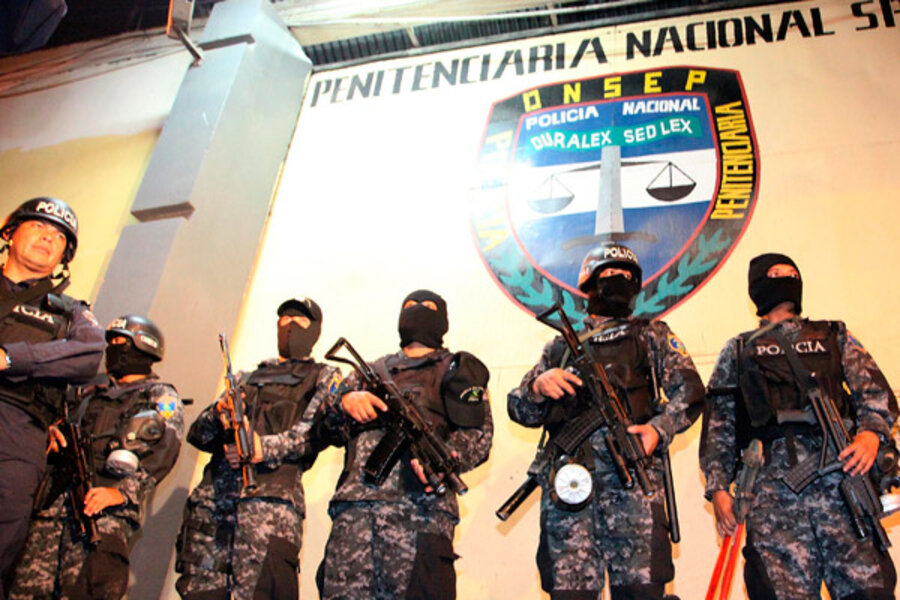Honduras: home to the most violent city in the hemisphere?
Loading...
Reports that San Pedro Sula, Honduras, has taken the place of Ciudad Juarez, Mexico, as the most violent city in the hemisphere are a result of shifts in trafficking patterns that are putting Central America at the heart of the drug trade.
According to a new report by Mexico’s Civic Council on Public Security and Criminal Justice, San Pedro Sula saw 159 homicides per 100,000 residents last year, topping the nonprofit organization’s list of the most violent cities in the hemisphere. Ciudad Juarez has topped the list for the past three years.
This shift in ranking reflects major changes that have occurred within the regional drug trade over the past decade, in which Mexican drug traffickers have deepened their influence in Central America. There they have established connections to local crime bosses, known as “transportistas,” who facilitate drug shipments between South America and Mexico. The rise of these transportistas has been accompanied by a surge of violence in the region, which is exacerbated by a growing local market for drugs, weak state institutions, and government corruption.
By contrast, Mexico has seen some success in its own struggle with organized crime, apprehending or killing several top drug traffickers in recent years. And while recently released government statistics show that homicides linked to organized crime increased 11 percent in 2011, the 2010 figure was 70 percent higher than in 2009, suggesting that the wave of violence in the country may be abating. It should also be noted that although Mexico's violence dominates headlines in the US, it pales by comparison to the situation in Central America. According to the United Nations’ 2011 Global Study on Homicide, the average homicide rate in the six biggest countries of Central America is 43 per 100,000, which is more than twice that of Mexico.
Honduras leads the UN list with 82.1 homicides per 100,000, making it the most dangerous country in the world in terms of murders. This prompted the US to pull its Peace Corps volunteers from the country due to safety concerns. As InSight Crime has reported, Honduras has been particularly affected by the growth of transnational drug trafficking in Central America. In September 2011, Honduran Defense Minister Marlon Pascua claimed that 87 percent of cocaine which is sent from South America to the United States passes through Honduras. If this is accurate, then, taken with the United Nations’ latest estimates of the size of the US cocaine market, it suggests that an incredible 143.55 tons of the drug pass through Honduras annually.
But despite Honduras’ status as a major drug transit nation, relatively little is known about the major criminal players in the country. According to security analyst James Bosworth, the process is mostly overseen by three of the most powerful drug trafficking organizations in Mexico: the Zetas, the Sinaloa Cartel, and the Gulf Cartel. In a December 2010 working paper on crime in Honduras for the Wilson Center, he claimed that US drug-enforcement officials believe “a large portion of the management” of these drug trafficking networks are Mexican, and are mostly affiliated with one of these three major groups.
These groups also appear to have different preferred methods of transporting their goods northward. Bosworth writes that “in general, according to experts who track the shipments, the Sinaloa and Gulf Cartels move more cocaine by land across the Honduras-Guatemala border while the Zetas move more by sea.” Their exact areas of influence are unknown, but the government has acknowledged their presence in at least four provinces along the western border with Guatemala and the northern coast.
These organizations do not work alone. As mentioned above, Mexican drug-trafficking groups frequently depend on local transportistas to supply them with their product from South America. In Honduras, the most high profile transportistas are Nelson and Javier Rivera, brothers who turned a mid-level car and cattle theft operation into an extensive drug-running venture with ties to government officials, known as the Cachiros gang. The Cachiros’ influence stretches all along the northern coast, as well as the eastern provinces of Gracias a Dios and Olancho. Other smaller transportista networks, such as the El Salvador-based Perrones, also operate in the country.
On the street level, Honduras is also home to the gangs that have sprung up throughout the region; Barrio 18 and their rivals, the Mara Salvatrucha (MS-13). Street gangs like these two groups are likely responsible for a majority of the violence in San Pedro Sula. As a series on the city by La Prensa reveals, at least 10 entire neighborhoods on the outskirts of the city are completely in the hands of these gangs, and police are unable to even enter them. Extortion, sometimes referred to as a “war tax,” is common in San Pedro Sula, especially targeting transport workers such as bus and taxi cab drivers. To make matters worse, small-scale drug trafficking is on the rise in the city, which could lead to more violent turf wars.
There appears to be no evidence that the violence in San Pedro Sula is caused by any kind of overarching conflict between Mexican cartels, as is taking place in the border cities in the north of Mexico like Juarez or Tijuana. However, it is likely that the Mexican groups active in the country are at least present in the Honduran city, if not major contributors to the violence.
San Pedro Sula is an economic powerhouse, producing two-thirds of Honduras’ GDP. Because the flow of capital there is far greater than in any other city in the country, it is an ideal place to launder money. It is also located relatively close to both the border with Guatemala and Puerto Cortes, Honduras’ main port, making it strategically situated to direct smuggling networks.
--- Geoffrey Ramsey is a writer for Insight – Organized Crime in the Americas, which provides research, analysis, and investigation of the criminal world throughout the region. Find all of his research here.







